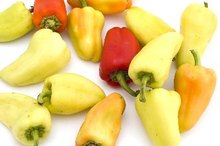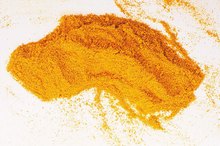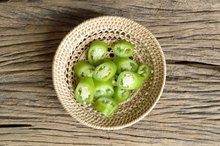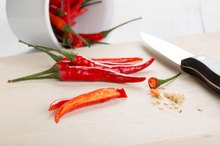What Is the Difference Between Cayenne Powder & Cayenne Pepper?
If you are cutting back on sodium in your meals, use more spices to increase flavor without using salt. As you become more familiar with different spices, you start hearing names that are similar and yet you can’t figure out if they are referring to the same thing. Cayenne pepper and cayenne powder are one such case.
Difference
The cayenne pepper is a very hot vegetable pepper, and cayenne powder is made from ground, dried cayenne peppers. This type of pepper is not the same as the pepper spice you see in shakers along with salt 1. Pepper spices such as black pepper are the ground-up peppercorns of the Piper nigrum plant and other species that produce peppercorn-like fruits, such as Szechuan pepper. Note that you might see bottles of cayenne powder labeled as cayenne pepper as the contents of the bottle are still technically cayenne peppers, just in powdered form.
- The cayenne pepper is a very hot vegetable pepper, and cayenne powder is made from ground, dried cayenne peppers.
- Pepper spices such as black pepper are the ground-up peppercorns of the Piper nigrum plant and other species that produce peppercorn-like fruits, such as Szechuan pepper.
Identification
Differences Between Cayenne Pepper & Jalapeno
Learn More
Cayenne peppers are part of the Capiscum genus, which includes other well-known hot peppers such as jalapenos, serranos, tabascos and habaneros. Cayenne peppers are thin, pointy peppers that start off green and ripen to a red color. Cayenne has a medium-to-high Scoville rating of anywhere from 5,000 to 60,000 Scoville units, though you’ll more typically see ratings of 30,000 to 50,000. The Scoville scale is a relative heat scale for peppers. For comparison, bell peppers are at 0, and habanero and Thai peppers can hover around 60,000 to 100,000 units, depending on whom you speak to.
- Cayenne peppers are part of the Capiscum genus, which includes other well-known hot peppers such as jalapenos, serranos, tabascos and habaneros.
- For comparison, bell peppers are at 0, and habanero and Thai peppers can hover around 60,000 to 100,000 units, depending on whom you speak to.
Uses
The pepper itself is mainly used in food. Chop it up for soups or sauces, but be very careful when cutting it or otherwise handling it. Be warned that a little can go a very long way, so if this is the first time you’ve used cayenne pepper, start off with only a small bit. Wear gloves or wash your hands after handling the pepper and before touching anything. You can also use the powder in cooking 1. Again, watch out regarding how much you use, and wash your hands. Do not try to sniff cayenne powder to see what it smells like, because you may accidentally inhale it. Sprinkling a border of cayenne powder, or a mix of the powder and other spices, around plants is a part of some natural pest control methods. The University of Maryland Medical Center notes cayenne also has a history of traditional medical use in Asia, and cayenne pepper and powder also serve as a source of capsaicin, which is used in topical creams for conditions like psoriasis.
- The pepper itself is mainly used in food.
- Sprinkling a border of cayenne powder, or a mix of the powder and other spices, around plants is a part of some natural pest control methods.
Cautions
Foods Containing Capsaicin
Learn More
Consult with your doctor before taking cayenne or oral capsaicin supplements. The University of Maryland Medical Center warns capsaicin creams can create a short-term burning feeling on your skin and that they are not easy to wash off. Keep the creams off irritated or broken skin. The supplements can lead to stomach upset, and at least one of cayenne’s possible uses, to relieve cluster headaches, should not be attempted at all without medical supervision.
- Consult with your doctor before taking cayenne or oral capsaicin supplements.
- The University of Maryland Medical Center warns capsaicin creams can create a short-term burning feeling on your skin and that they are not easy to wash off.
Related Articles
References
- What’s Cooking America; Pepper -- the Master Spice; Eileen Troemel
- University of Illinois Extension: Peppers
- Brandeis University; Some Like It Hot -- Really Hot!; Robert Sekuler; 2004
- Texas Cooperative Extension; Classifying Chile Peppers; July-August 2007
- North Dakota State University; Questions on Squirrels; Ron Smith
- “Journal of Chemical Education”; Hot Chili Peppers: Extraction, Cleanup, and Measurement of Capsaicin; J. Huang, et al.; December 2000
- University of Rochester Medical Center, Health Encyclopedia: Cayenne
- Harvard Medical School, Harvard Women's Health Watch, "The dubious practice of detox." May 2008
- Reinbach HC, Smeets A, Martinussen T, Møller P, Westerterp-plantenga MS. Effects of capsaicin, green tea and CH-19 sweet pepper on appetite and energy intake in humans in negative and positive energy balance. Clin Nutr. 2009;28(3):260-5. DOI:10.1016/j.clnu.2009.01.010
- National Institutes of Health, Office of Dietary Supplements, "Dietary Supplements for Weight Loss, Fact Sheet for Health Professionals."
- Esmaillzadeh A, Keshteli AH, Hajishafiee M, Feizi A, Feinle-bisset C, Adibi P. Consumption of spicy foods and the prevalence of irritable bowel syndrome. World J Gastroenterol. 2013;19(38):6465-71. DOI:10.3748/wjg.v19.i38.6465
- Gagnier JJ, van Tulder M, Berman B, Bombardier C. Herbal medicine for low back pain. Cochrane Database Syst Rev. 2006 Apr 19;(2):CD004504.
- McCarty MF, DiNicolantonio JJ, O'Keefe JH. Capsaicin may have important potential for promoting vascular and metabolic health. Open Heart. 2015 Jun 17;2(1):e000262.
- Kim CS, Kawada T, Kim BS, et al. Capsaicin exhibits anti-inflammatory property by inhibiting IkB-a degradation in LPS-stimulated peritoneal macrophages. Cell Signal. 2003 Mar;15(3):299-306.
- Laslett LL, Jones G. Capsaicin for osteoarthritis pain. Prog Drug Res. 2014;68:277-91.
- Leung FW. Capsaicin as an anti-obesity drug. Prog Drug Res. 2014;68:171-9.
Writer Bio
Suzanne S. Wiley is an editor and writer in Southern California. She has been editing since 1989 and began writing in 2009. Wiley received her master's degree from the University of Texas and her work appears on various websites.









